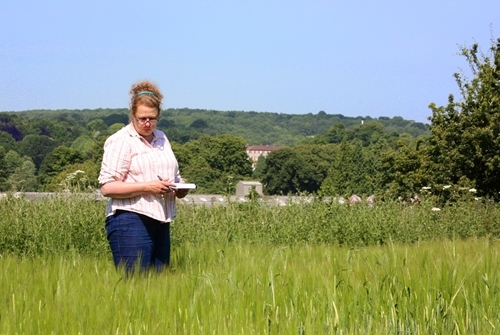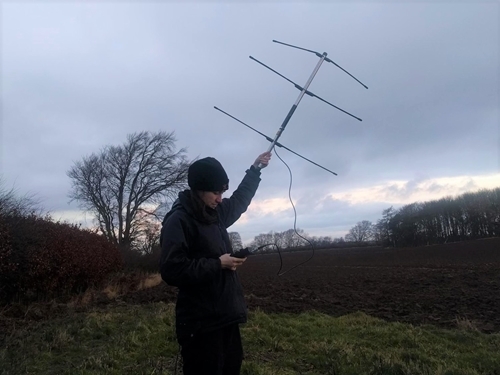How I developed in the world of Science by Julie Ewald

Growing up in rural Nebraska, the only careers that seemed possible to those of us with an interest in biology and other sciences were ones that involved medicine in some guise. It was only when I took my first Zoology class at the University of Nebraska (UNL) that I really got interested in a career in research. My lecturer was Dr Brent Nickol and one of the Biology Department’s PhD students, Janine Caira, was my laboratory teaching assistant. Both Brent and Janine had an enthusiasm for learning generally and scientific knowledge and research specifically that was infectious. Both have gone on to win national recognition for their dedication to teaching as well as research.
Janine was informal in her approach and made scientific study seem tremendously appealing, with the research for her PhD taking her to the Sea of Cortez (pull out your Steinbeck* if you need to be reminded where that is) to collect sharks. Brent Nickol expected students to work hard, learn, and to demonstrate that learning in what were rumoured to be some of the most difficult exams on campus. If you met his exacting standards then you were included in a select group that got invited along to the Southwestern Association of Parasitologists meetings at a research station on the Oklahoma-Texas border, where you listened to the Cleveland Indians win the 1948 World Series on an eight-track cassette player, went looking for armadillos, walked on beaches made up of fossilised snail shells and discussed the great ecological questions of the day into the wee hours of the night – while still being up to hear the first research talk the next morning.
A heady mix that ended up with many of us deciding to pursue a career in research. I became Brent Nickol’s next master’s student and went on to do my PhD with one of his main scientific collaborators, David Crompton, at the University of Glasgow. *The Log from the Sea of Cortez, Steinbeck, J. 1951.
I have been working at the Trust for over 20 years and am the second longest serving female scientist at the Trust – with only Dr Maureen Woodburn having been at the Trust for a longer time. We follow in a long line of women working at what has become the GWCT, with the first female scientist being Phyllis A. Clapham DSc. Dr Clapham studied parasitic worms in birds and published many of the early scientific articles produced at what was then The Game Research Station from the 1930s to the 1950s.
At the time Dr Clapham would have been unusual; a female research scientist was not that common in the first half of the last century. Looking around now, with the current research staff of the GWCT, female scientists can be found throughout the organisation. More than half of our sandwich placement intake every year are young women, and it seems that efforts to make ecology and conservation research equally accessible to women and men have been successful. We can celebrate the advances that have been made even though we are not yet to the point of parity in the older generations of researchers here at the Trust.
Ecological research still suffers (as do other scientific occupations) with what is termed a “leaky pipeline”, where women leave the profession at higher rates than men. Providing equal career development opportunities going forward will be key to retaining young female researchers, and the Trust sees this as a key part of our involvement in the Investors in People initiative, as is the necessity of developing the skills of all our staff.
Why to work in the world of Science by Marlies Nicolai

Currently I work as a full time Research Assistant for the GWCT based on the Game and Wildlife Scottish Demonstration Farm. My primary role is to collect data for ecological analysis within upland agricultural systems and moorland/heathland habitats. Firstly, it is important to state that for me, it is not just a job, but also a lifestyle choice. Not only can I indulge in the beautiful surroundings and appreciate nature for its visual aspects daily, but most importantly, I am continually learning about the intricate interactions which occur between plants, animals and their environment through both direct observation, monitoring and research.
All my life I have had a passion for the outdoors and nature, which stemmed from being raised on a farm in Zimbabwe. Consequently, in my later years I followed my passion and undertook a number of different research/conservation jobs in southern Africa before returning to Scotland. Working in the science world, especially in relation to research monitoring and conservation, it is both a joy and privilege. It is a career path which I would highly recommend due to its interesting, fulfilling, variable and versatile nature and somewhat physical demands.
When I was at school, students were encouraged to pick a career path relatively early with the expectations of specialising in something at the age of 13. Countless Personal and Social Education classes often, for me, led to confusion, uncertainty and a lack of confidence rather than clarity and security for the future. Frequently we would be presented with a list of what I call “adhering to the norm jobs” such as nurse, doctor, accountant, journalist, teacher etc, but never did it say what I wanted to do: ecologist or game reserve manager, or conservation scientist/ranger.
The closest job which fitted my requirements was Scientist. However, when you’re young and you think of people who are scientists, one may think of people such as Charles Darwin, Albert Einstein and Benjamin Franklin, or maybe even Victor Frankenstein. As I was not an exceptionally academic student, I thought it was a job far, far beyond my reach not only because of IQ and lack of a crazy and obscure hairstyle and demeanour, but the only successful scientists I knew of were men. My path wavered as a result and I decided to focus on physical education instead. By the time I was 18, I however decided to scrap my old-fashioned and warped view of who can and cannot be a scientist and I went to university to study Conservation Biology.
We are told women are underrepresented in the field of science. The majority of famous scientists are indeed men, as the individuals we tend to think of were of a completely different time when women were undervalued and underrepresented in the majority of job sectors. It was also a time of great discovery, as little was known of our world. Women in science is a recent development, therefore it is understandable that there are few historically famous women scientists apart from exceptions such as Rosalind Franklin, Marie Curie and Ada Lovelace.
Times have only relatively recently changed and I believe many women will be the leading faces of science. They now have far greater opportunities than ever before, and science is becoming ever more complex and explorative. For those who are uncertain of their future career paths, especially young women, I would encourage you to consider, and to have the confidence to pursue a career in science. Being a scientist does not mean you need to be a feat of unprecedented intelligence and discovery, but a scientist is any person with any kind of knowledge or expertise in any of the science faculties. It is now possible to contribute to the world of science in ways big or small, man or women, as we now live in an era of equal opportunities and anything is possible.
How I became interested in science and how we can get more women and girls interested by Fiona Torrance

My name is Fiona and I’m the Scottish Grey Partridge Recovery Project Research Assistant at the GWCT. My role involves surveying wildlife like grey partridges, breeding birds and brown hares as well as working with various stakeholders to try and improve farmland for biodiversity in a way that works for farmers. I LOVE my job. Not only do I get to work outdoors, see lots of wildlife and work with like-minded people, but, most importantly, I know I’m helping to make a difference.
I’ve always been interested in science for as long as I can remember. A lot of children have a ‘dinosaur phase’ or ‘space phase’ but unlike most, my ‘phases’ led from one to another and never really stopped. My parents were great at taking me to various museums, country parks, zoos, etc when I was a child. To me, these were places where I could discover both what the world was and had been like, and explore what it had to offer. In particular, the environment, was the area I was constantly drawn to. As I got older, I became more aware of the various challenges facing biodiversity and knew that I wanted to do something about it. What that was, I had no idea, but decided a degree in zoology was a good place to start. Since then, I haven’t looked back, and have been fortunate enough to work and volunteer in the environment sector since I graduated 10 years ago.
When it comes to getting more women and girls interested in science, I think it’s important to make sure doors are always left open. Curiosity and a willingness to learn should always be encouraged in young people. Role models are also important. There are certainly more on TV than there used to be, but social media is perhaps the biggest area where this has expanded, and people can see what being a scientist is really like. It’s up to us to make sure that we offer advice, support and guidance and show how rewarding a career in science can be.